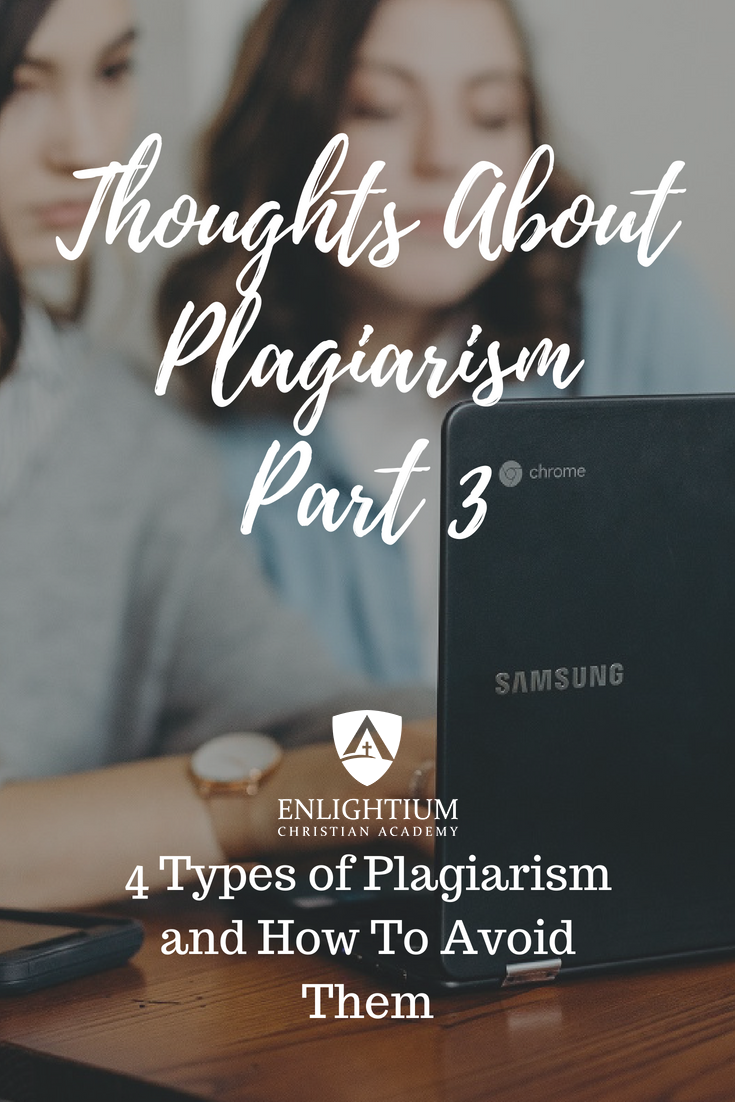Some Thoughts About Plagiarism Part 3: Four Types of Plagiarism and How to Avoid Them
Dear Students,
In my recent Internet lurking I came a tumblr post or tweet by a student that said something like this
“I don’t know how people plagiarize on purpose. I’m terrified that I will fail because I accidentally used the same wording as a 16th-century manual on toasters.”
(If you are wondering why I didn’t link to the exact tweet, go ahead and try to find a social media post from twitter, tubmlr, or instagram you saw as part of a list posted on someone’s blog two weeks ago.)
 My point is, accidental plagiarism is a real fear for some students. This became even clearer as I tried to find the above post and found myself in the corner of the Internet devoted to this topic. I want to help you out with that right now: While certain word combinations are common, the chances of you describing a specific subject in the exact same words and grammar structure as another human being by accident are so low they are basically impossible. What is more likely is that you might be doing something you don’t realize is plagiarism.
My point is, accidental plagiarism is a real fear for some students. This became even clearer as I tried to find the above post and found myself in the corner of the Internet devoted to this topic. I want to help you out with that right now: While certain word combinations are common, the chances of you describing a specific subject in the exact same words and grammar structure as another human being by accident are so low they are basically impossible. What is more likely is that you might be doing something you don’t realize is plagiarism.
In this post, I’m going to define four different types of plagiarism and tell you how to avoid them. The goal is to clarify plagiarism and thus help reduce anxiety. If you have any questions, please talk to your teacher.
This is the third and final entry in a series discussing plagiarism. You can read Part 1: An Open Letter to Students Dispelling Myths About Plagiarism and Part 2: What Sets Off My Teacher Spidey-Senses on the Enlightium Academy Blog.
Conventional Plagiarism
I’m including standard, run-of-the-mill plagiarism to cover all my bases. It goes like this: You need help on an assignment. You turn to the Internet or another source. You find something that fits. You copy all or part of it into your assignment and turn it in as an original answer.
- Why this could be an accident: Plagiarism is very much a cultural construct. In some cultures, borrowing information from others is not considered stealing. In fact, it can be a form of showing respect. Not so in the US.
- How you can avoid it: When you use a source, always add citations, whether it’s for a direct quote (in which case you also need quotation marks) or a specific piece of information. A good rule of thumb is: If you couldn’t have known the information without reading the source, you need a citation.
Plagiarism of Ideas through Synonyms
You have found a source that exactly fits the assignment, but copy/pasting is bad. You know this, and you have no intention of plagiarizing. So you go through and summarize each sentence in your own words. Here and there you borrow a phrase, because you can’t think of a better way to say it. Okay, maybe you borrow more phrases than you intended, but the text is not the same and the plagiarism checker doesn’t find a problem, so it’s not plagiarism, right?
Wrong! This is not your original writing. Sentence for sentence, the ideas and grammar structures are exactly the same as those in your source. This is still plagiarism.
Here is another way to think about this: rewriting content sentence by sentence is paraphrasing. Most teachers consider paraphrasing a form of quotation. A quote is not your original work, and unless you cite it properly, it is plagiarized. In addition, your teacher probably has a limit on how much of your paper can be made up of quotes. If your whole paper is paraphrased, then it is over the limit.
- Why this could be an accident: Especially for younger students, this is a difficult distinction to understand. You didn’t copy/paste after all. However, it’s important to realize that if the ideas and how they are expressed are not yours, you are still plagiarizing. It is also worth mentioning that there are students who do do this on purpose, though it seems like a lot of work to avoid doing work.
- How you can avoid it: If you want to use information from a source and rewrite it in your own words, don’t go back and forth between the source and your paper. Start by taking notes on the main ideas and thinking about how they apply to your assignment. Then close the source. Using only your notes, write the ideas in your own words, and don’t forget to cite the source. Remember: If you couldn’t have known the information without reading the source, you need a citation.
Self-Plagiarism
Your teacher assigned a paper on a topic you already wrote about for another course. Score! You make a few tune-ups, change the date and turn it in. Major time-saver.
This is faulty thinking, based on the idea that the purpose of an assignment is to submit something - anything. In fact, an essay is an assessment tool and a way for your teacher to see if you have learned certain skills that were taught in the class, one of which is most certainly the process of writing an essay. It’s also a teaching tool, that helps you learn.
- Why this could be an accident: This is another difficult distinction to understand. After all, you didn’t turn in something written by another person, pretending you wrote it. However, you are turning in something you wrote previously, pretending that you just wrote it for this assignment.
- How you can avoid it: Don’t try to double-dip in your assignments. Now, there could be some teachers who will make an exception. You can ask. But don’t be surprised if the answer is no.
Third Party Plagiarism
Someone else wrote the paper for you and you turned it in as your own. Now, on the surface, this seems pretty straight-forward, right? Write your own papers.
- Why this could be an accident: One of the really positive things you can do in writing is get feedback from another person. Unfortunately, sometimes the person helping can become over-eager and add their own ideas, or even rewrite portions of your paper for you. This is a very difficult line, and a lot of responsibility lies with the tutor. However, the responsibility also lies with YOU. You are the one who is turning in the paper, and you are the one who will have to face consequences if your teacher discovers it is not entirely your original work.
- How you can avoid it: Make sure you are the only one writing your paper, and that any ideas added are ideas you develop yourself. There is a difference between someone helping you to proofread and discussing the organization and ideas with you and someone rewriting parts of the paper for you. Simply put, whose hands are on the keyboard? Whose words are on the page? Whose ideas are you turning in as your own?
Another way to avoid confusion is to keep your drafts and outlines. This will keep you on track with your ideas, and will also help your teacher see where your ideas came from.
I know plagiarism is a difficult topic to discuss, and the last thing I would want to do is make someone feel like I am accusing him or her. I do, in fact, know that the majority of my students don’t plagiarize. But I also know that in a digital age where everything is at your fingertips it’s a temptation and that understanding what is and isn’t plagiarism is difficult. So I am asking you to engage with your teachers on this topic and let them know if you have any questions or comments.
Bio of a Plagiarism Expert:
When I first saw the description of myself as a plagiarism expert, I was startled. I don’t think of myself this way. I just think of myself as a teacher with good observational skills (which is really just a requirement for teachers).
I’ve taught in quite a few different settings, and I still remember being a student. I tell my students that I have a super power: I can tell at a glance if the formatting of a paper is even a little bit off. I can tell if the margins are wrong; I can tell if the font size is wrong; I can tell if the spacing has been selectively changed to stretch the length of a paper. Of course, with word count technology, paper length is rarely anymore determined by page count.
I can also tell if the wording is unnecessarily complicated to extend the length of the paper. I can also often tell if something is partly or completely plagiarized. It turns out that a lot of the skills I had to learn as a student (textual analysis, word choice, identifying voice) are the same skills that help me identify unoriginal writing. And I’m not alone in this. Most teachers I know are pretty aware.
What I want students to get from this mini-series is a way to enter into the discussion about plagiarism. I fear that so far most of the communications I’ve had with students about plagiarism is a big sign with an “X”. Don’t do it! But like all issues, this is complex. General and specific discussion can increase understanding, decrease fear, and allow students to see plagiarism as more than one more arbitrary rule in academics. I don’t want to wait to talk to students about plagiarism until it comes up as an issue with their assignment.
Enlightium Academy is an accredited alternative schooling option for educating your child from home. Our program offers the comfort of a homeschool environment with a quality private school curriculum. Enlightium Academy is a private Christian school that offers a Bible-based, flexible, accredited, teacher supported, and affordable education. Enlightium Academy meets all accreditation and state education requirements for all 50 states, while neither using the state curriculum or Common Core.

